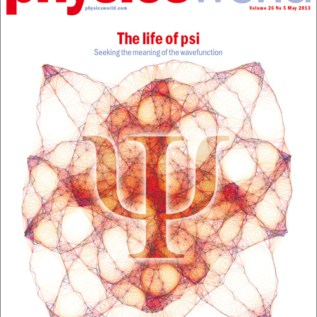By Louise Mayor
Yesterday I had an exciting trip out of the office.

Earlier this week, one of Physics World’s freelance writers, Jon Cartwright, told how me he’d been invited to the Bristol University theory department’s weekly seminar. Felix Flicker, a 2nd-year PhD student who organizes these events, had seen Jon’s article “The life of psi” in this month’s Physics World, which discusses a theorem published in Nature Physics. The theorem is interesting because if its assumptions hold, it rules out one of the four interpretations of quantum mechanics and leaves us with three.
I wanted in on the seminar action!
Last year when I was planning the Physics World special issue on quantum frontiers (which was out in March and is still available as a free PDF download), I had approached Jon to ask whether he’d like to tackle a quantum topic, and he let me know he was interested in covering the paper by Matthew Pusey, Jonathan Barrett and Terry Rudolph. Jon had seen the story reported elsewhere but had found these accounts were light on the details and didn’t get to the bottom of the science. I liked the idea and Jon went ahead. Once the story arrived in my inbox I was hooked! I found it to be one of those stories that covers some tricky concepts but if you let yourself become immersed in the story and think through what’s being explained, is very rewarding.
Having worked with Jon to edit the article, I felt quite invested in it and was keen to see what it would lead to with this seminar. Another reason for going was that, having become Physics World’s features editor after finishing my physics PhD four years ago, the everyday workings of a physics department – working through ideas, the all-important discussions in the tea room, etc – are now usually off-limits to me. Yes, I meet a lot of scientists in more formal situations and at conferences, but I rarely see the actual workings of a research group rather than its public face. As well, any feedback from Physics World’s audience (or potential audience) about what topics they’d like to see covered by Physics World, and whether they find the articles too hard, too easy or just right, all feeds back to inform what we cover, and how, in future.
Into the fray
After being welcomed by Felix, Jon and I headed up to the seminar room. Eight more condensed-matter and quantum information theory researchers trickled in ready for the two o’clock start. I was excited to see what would unfold over the next hour, and slightly nervous that, being a non-specialist in quantum theory, I might say something “stupid” and end up embarrassing myself.
To kick off, Felix explained that the main idea was to talk through the paper, which people had read in preparation, and make sure that everyone understood it. On the whiteboard, Felix wrote the two assumptions of the paper along with a running order of discussion points. Early on, Jon was invited to run through the four different interpretations of quantum mechanics, and did so admirably with the help of the flowchart in his article. I hadn’t realized until then that this flowchart was an original idea Jon had come up with himself for Physics World. I find the chart really helpful in understanding what different points of view lead to the four interpretations; you can go through answering yes-or-no questions to reveal your own interpretation.
Initially I just about followed the discussion, but eventually I got lost and became more of a spectator and people-watcher than an active participant. As such, I was able to sit back and watch, which enabled me to notice two discrete modes of discussion in the seminar.
In the first half, people slowly discussed and thrashed out their understandings; the progression in understanding was slow but sure, and no question was deemed too stupid. This supportive environment reminded me of working with my peers through difficult problem sets in the latter years of my undergraduate degree. I know that, for me, this was the kind of situation where I learned most.
Halfway through, another researcher came in, in a whirlwind of enthusiasm and explanations, and from then on things moved up a notch and I got even more lost, in discussions such as whether certain variables were in Hilbert space or not. Once this new guy came in, there had been a step-change in the mode of operations with most questions now being directed to and clarified by him. By the end of the hour it seemed everyone’s understanding had progressed, with the two learning approaches complementing each other well.
So what did the group make of the paper? Wrapping up the discussion, someone commented “It’s a very nice result…but I don’t think it’s actually changed anyone’s mind out there.”
It was a fun trip and reminded me of what’s involved in the process of learning about and researching physics. I think I made a great contact in Felix – he had one story idea for me and I had an idea for a future seminar topic for him. At Physics World, we keep our fingers on the pulse by reading press releases, papers and blogs; and by going to conferences. But perhaps most valuable are our interactions with the individual contacts we have in the world of physics.



